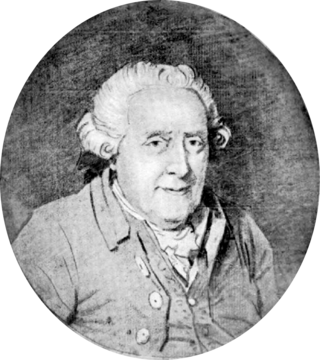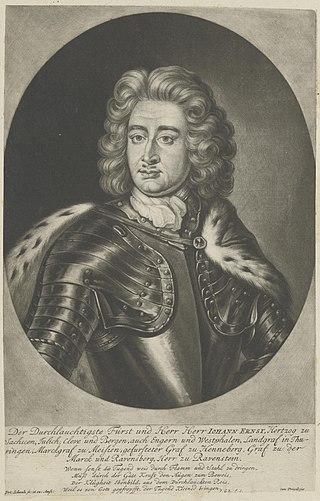
Carl Philipp Emanuel Bach, also formerly spelled Karl Philipp Emmanuel Bach, and commonly abbreviated C. P. E. Bach, was a German Classical period composer and musician, the fifth child and second surviving son of Johann Sebastian Bach and Maria Barbara Bach.

Wilhelm Friedemann Bach was a German composer, organist and harpsichordist. He was the second child and eldest son of Johann Sebastian Bach and Maria Barbara Bach. Despite his acknowledged genius as an improviser and composer, his income and employment were unstable, and he died in poverty.
Johann Gottfried Bernhard Bach was a German musician. It is not known whether he composed, and his career as an organist is not in itself notable, but his life throws light on his famous father, the composer Johann Sebastian Bach. Johann Gottfried was the fourth child of Johann Sebastian Bach and Maria Barbara Bach to reach adulthood.
The year 1718 in music involved some significant events.

"Alles mit Gott und nichts ohn' ihn", BWV 1127, is Johann Sebastian Bach's October 1713 setting of a poem in 12 stanzas by Johann Anton Mylius, Superintendent of Buttstädt, a town in the Duchy of Saxe-Weimar. The poem is an acrostic dedicated to Duke Wilhelm Ernst of Saxe-Weimar, on his birthday. Bach, at the time employed as court organist by the Duke, set Mylius's ode as an aria in strophic form, that is a melody for soprano accompanied by continuo for the stanzas, alternated with a ritornello for strings and continuo. When all stanzas are sung, a performance of the work takes around 45 to 50 minutes.

William Ernest, Duke of Saxe-Weimar was a duke of Saxe-Weimar.

John Ernest III, was a duke of Saxe-Weimar.

Johann Sebastian Bach was a German composer and musician of the late Baroque period. He is known for his prolific authorship of music across a variety of instruments and forms, including; orchestral music such as the Brandenburg Concertos; solo instrumental works such as the cello suites and sonatas and partitas for solo violin; keyboard works such as the Goldberg Variations and The Well-Tempered Clavier; organ works such as the Schubler Chorales and the Toccata and Fugue in D minor; and choral works such as the St Matthew Passion and the Mass in B minor. Since the 19th-century Bach Revival, he has been generally regarded as one of the greatest composers in the history of Western music.
The year 1652 in music involved some significant events.

St. Thomas School, Leipzig is a co-educational and public boarding school in Leipzig, Saxony, Germany. It was founded by the Augustinians in 1212 and is one of the oldest schools in the world.

Ernst Wilhelm Wolf was a German composer.
Johann Samuel Drese was a German composer. In 1683 he was appointed Kapellmeister of the ducal court in Weimar. He held this post until his death which meant that he was in charge of music at court during almost all the time Johann Sebastian Bach was working in Weimar, a brief stay in 1703 and a second period from 1708 until after Drese's death.
Adam Drese was a German composer, kapellmeister, and bass viol player of the baroque period.

Johann Ernst of Saxe-Weimar was a German prince, son by his second marriage of Johann Ernst III, Duke of Saxe-Weimar. Despite his early death he is remembered as a collector and commissioner of music and as a composer, some of whose concertos were arranged for harpsichord or organ by Johann Sebastian Bach, who was court organist in Weimar at the time.

Erschallet, ihr Lieder, erklinget, ihr Saiten!, BWV 172, is a church cantata by Johann Sebastian Bach, composed in Weimar for Pentecost Sunday in 1714. Bach led the first performance on 20 May 1714 in the Schlosskirche, the court chapel in the ducal Schloss. Erschallet, ihr Lieder is an early work in a genre to which he later contributed complete cantata cycles for all occasions of the liturgical year.

Johann Sebastian Bach composed the church cantata Komm, du süße Todesstunde, BWV 161, in Weimar for the 16th Sunday after Trinity, probably first performed on 27 September 1716.
The Weimarer Passion, BWV deest, is a hypothetical Passion oratorio by Johann Sebastian Bach, thought to have possibly been performed on Good Friday 26 March 1717 at Gotha on the basis of a payment of 12 Thaler on 12 April 1717 to "Concert Meister Bachen". It is one of several such lost Passions. Both the text and music are lost, but individual movements from this work could have been reused in latter works such as the Johannes-Passion. At one time, it was thought that the work set chapters 26 and 27 of the Gospel of Matthew to music, with interspersed chorales and arias, but current consensus is that it is possible that the text reflected a synopsis of two or more Gospel texts, as well as the interspersed chorales and arias.

O heilges Geist- und Wasserbad, BWV 165, is a church cantata by Johann Sebastian Bach. He composed it in Weimar for Trinity Sunday and led the first performance on 16 June 1715.

Herz und Mund und Tat und Leben, BWV 147.1, BWV 147a, is a cantata by Johann Sebastian Bach. He composed it in Weimar in 1716 for the fourth Sunday in Advent, 20 December. It is uncertain if the work was performed then. He later expanded the work in 1723 as Herz und Mund und Tat und Leben, BWV 147.
The concerto transcriptions of Johann Sebastian Bach date from his second period at the court in Weimar (1708–1717). Bach transcribed for organ and harpsichord a number of Italian and Italianate concertos, mainly by Antonio Vivaldi, but with others by Alessandro Marcello, Benedetto Marcello, Georg Philipp Telemann and the musically talented Prince Johann Ernst of Saxe-Weimar. It is thought that most of the transcriptions were probably made in 1713–1714. Their publication by C.F. Peters in the 1850s and by Breitkopf & Härtel in the 1890s played a decisive role in the Vivaldi revival of the twentieth century.










